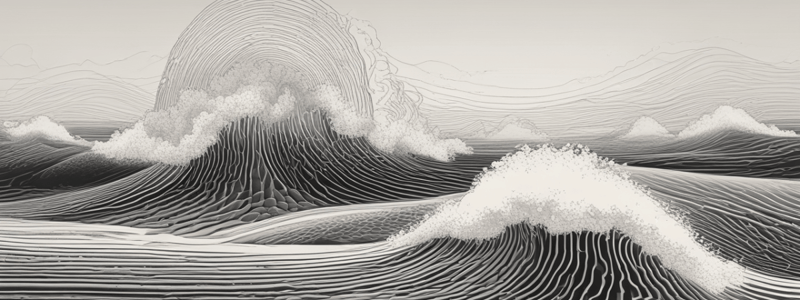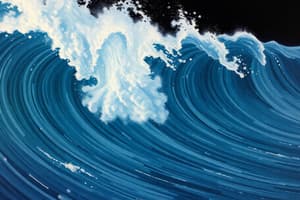Podcast
Questions and Answers
What is the defining characteristic of constructive interference?
What is the defining characteristic of constructive interference?
- Two waves meet and their amplitudes cancel each other out.
- Two waves meet and their frequencies increase.
- Two waves meet and their wavelengths shorten.
- Two waves meet and their amplitudes combine to create a larger wave. (correct)
What condition must be met for constructive interference to occur?
What condition must be met for constructive interference to occur?
- The waves must have different amplitudes.
- The waves must have different wavelengths.
- The waves must have the same amplitude and wavelength. (correct)
- The waves must travel through different mediums.
What happens to the amplitude of the wave during constructive interference?
What happens to the amplitude of the wave during constructive interference?
- The amplitude remains the same.
- The amplitude increases. (correct)
- The amplitude fluctuates unpredictably.
- The amplitude decreases.
Which of the following scenarios best describes constructive interference?
Which of the following scenarios best describes constructive interference?
What is the condition required for standing waves to occur?
What is the condition required for standing waves to occur?
Which of the following best describes the result of constructive interference?
Which of the following best describes the result of constructive interference?
What is the equation for constructive interference?
What is the equation for constructive interference?
Imagine two waves with amplitudes of 3 meters each. What would be the approximate amplitude of the resultant wave after constructive interference?
Imagine two waves with amplitudes of 3 meters each. What would be the approximate amplitude of the resultant wave after constructive interference?
What determines if the condition of constructive and destructive interference can be met?
What determines if the condition of constructive and destructive interference can be met?
What is the equation used to determine if constructive interference conditions are met?
What is the equation used to determine if constructive interference conditions are met?
What is the purpose of shifting the waves by half a wavelength in destructive interference?
What is the purpose of shifting the waves by half a wavelength in destructive interference?
What is the equation used to find the wavelength of waves traveling at an angle from their source to one point?
What is the equation used to find the wavelength of waves traveling at an angle from their source to one point?
What type of interference occurs when the sources of the waves are half a wavelength apart or a multiple of a wavelength in addition to half of a wavelength?
What type of interference occurs when the sources of the waves are half a wavelength apart or a multiple of a wavelength in addition to half of a wavelength?
What is an example of a contained medium that can produce standing waves?
What is an example of a contained medium that can produce standing waves?
What effect does destructive interference have on the amplitude of the resulting wave?
What effect does destructive interference have on the amplitude of the resulting wave?
Which scenario exemplifies destructive interference?
Which scenario exemplifies destructive interference?
In the context of sound waves, what does the Principle of Superposition state?
In the context of sound waves, what does the Principle of Superposition state?
What is a critical characteristic of noise-canceling headphones?
What is a critical characteristic of noise-canceling headphones?
During destructive interference, if one wave has an amplitude of +1 meters and another has -2 meters, what will the resultant amplitude be?
During destructive interference, if one wave has an amplitude of +1 meters and another has -2 meters, what will the resultant amplitude be?
What occurs when two waves reflect off each other?
What occurs when two waves reflect off each other?
Flashcards are hidden until you start studying
Study Notes
Wave Interference
- Occurs when two waves traveling through the same medium collide and produce a new wave.
- Can lead to two types: constructive interference and destructive interference.
Constructive Interference
- Happens when the crests and troughs of two waves align, leading to combined amplitudes.
- Required conditions include:
- Same medium, amplitude, and wavelength for both waves.
- The resultant wave has an amplitude larger than either original wave.
- Example: Two waves with an amplitude of 4 meters combine to form a resultant wave also of 4 meters.
Destructive Interference
- Occurs when the crest of one wave meets the trough of another, canceling out their amplitudes.
- Results in a flat line, indicating no net displacement of the medium.
- Used in noise-canceling headphones where waves from different sources cancel each other out.
Real-World Applications
- Constructive interference can make sounds louder when waves with identical frequencies collide.
- Destructive interference plays a role in cancelling noise, exhibiting its practical usefulness in technology.
Principle of Superposition
- States that the resultant amplitude of waves at any point is the sum of the individual wave displacements.
- In constructive interference, overlapping crests lead to larger amplitudes; in destructive interference, overlapping crest and trough reduce amplitude.
Reflection and Standing Waves
- Reflection occurs when waves bounce back, creating patterns of interference.
- When reflected and incident waves fulfill certain conditions, standing waves are formed.
- Standing waves are observable in musical instruments like guitars and flutes, where waves remain confined within a medium.
Equations
- Constructive Interference: Resultant Amplitude = Amplitude of Wave 1 + Amplitude of Wave 2.
- Destructive Interference: Resultant Amplitude = Amplitude of Wave 1 + Amplitude of Wave 2, where one amplitude is negative.
- Conditions for constructive or destructive interference depend on the distance between wave sources and their wavelengths:
- Constructive interference occurs when wave sources are separated by whole or even multiples of the wavelength.
- Destructive interference occurs with half-wavelength shifts.
Additional Details
- The interference of waves in terms of angles and distances can be modeled mathematically to predict outcomes of wave encounters.
- Factors such as frequency, amplitude, and phase differences are essential in determining the nature of interference.
Studying That Suits You
Use AI to generate personalized quizzes and flashcards to suit your learning preferences.




